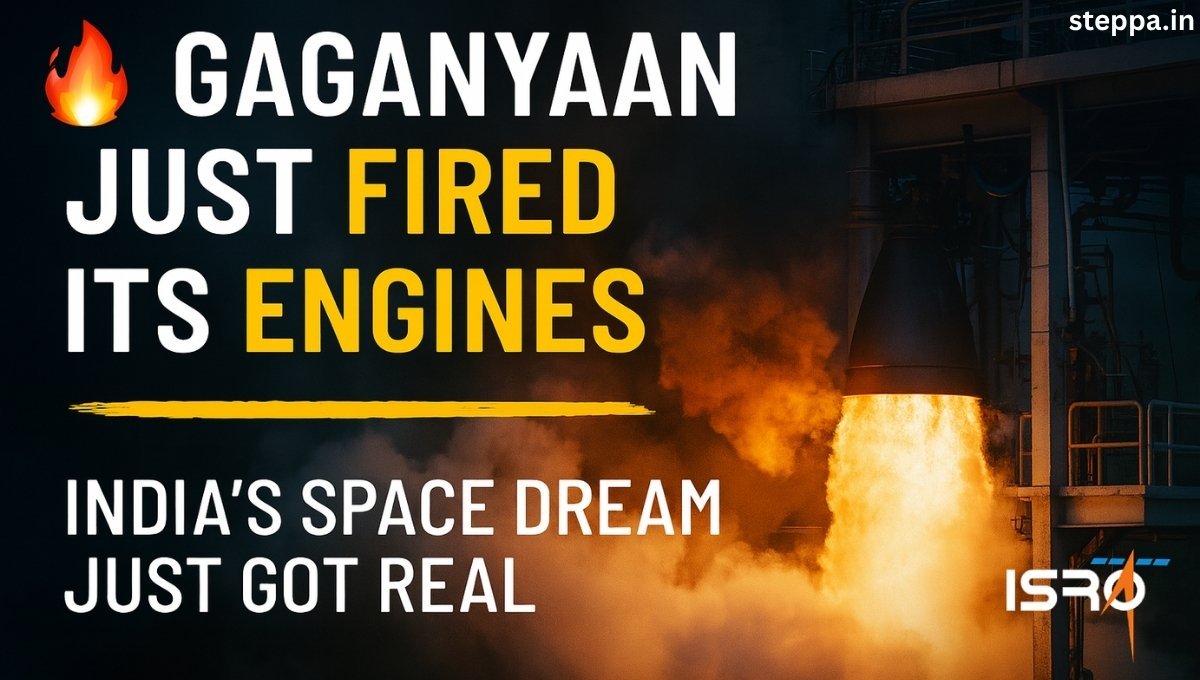1. What Actually Happened?
ISRO Gaganyaan Mission buzzing with excitement! They just nailed two engine test-firings for the Gaganyaan Service Module Propulsion System (SMPS). These aren’t your everyday tests — they’re the exact engines that’ll maneuver India’s first astronaut capsule when it’s floating above Earth. And yes, that includes emergency escape moves and orbital tweaks. Pretty solid stuff!
2. What Is SMPS?
SMPS is basically the thruster hub on Gaganyaan’s orbital module. Built by ISRO’s Liquid Propulsion Systems Centre (LPSC), it includes:
- 5 × Liquid Apogee Motors (LAMs) – each pushing 440 N thrust
- 16 × Reaction Control System (RCS) thrusters – each pushing 100 N thrust
Think of these as the main engines (LAMs) and steering jets (RCS) that guide the spacecraft.
3. The Tests: 30 s & 100 s Hot-Firings
They ran two firings:
- 30 seconds – validate system config
- 100 seconds – power through full simultaneous firing: LAMs + RCS (steady & pulsed)
Both tests performed exactly as expected. Nothing caught fire, nothing exploded—just smooth, precise thrust. ISRO now gears up for a full-duration hot test soon. Wow!
4. The NVS‑02 Hiccup – What Went Wrong
You might remember in January, ISRO launched NVS‑02 (NavIC satellite #2). It reached orbit fine, but its Liquid Apogee Motor didn’t fire. Why? The oxidizer valve didn’t open—so no ignition, no orbit correction, and the satellite got stuck. Yikes.
So, here’s why this matters: that same 440 N thruster (LAM) is used in Gaganyaan SMPS. Uh-oh. ISRO’s responding fast, adding hardware/software fixes, stricter quality checks, and review processes for upcoming NVS satellites.
5. Why These Tests Are Huge
- Confidence Boost: These early firings confirm system stability.
- Abort Preparedness: Gaganyaan has emergency escape modes—thrusters must perform, no doubt.
- Orbital Precision: Switching orientation or altitude requires precise control.
- Quality Lessons: NVS‑02 taught ISRO that valves matter. They’re correcting that.
6. Breaking Down the Tech
| Component | Role | Specs |
| LAM | Main engine for orbit changes | 440 N thrust, bipropellant (MMH + MON) |
| RCS thrusters | Orientation & small maneuvers | 100 N thrust, same fuel |
| Fuel combo | Reacts instantly (hypergolic) | MMH fuel + MON oxidizer |
| Test types | 30s preliminary, 100s full systems | Validated simultaneous operations |
7. Myth vs. Truth
Myth: “Hypergolic fuels are outdated.”
Truth: Actually, they’re super reliable—they ignite automatically on contact. Good for space ops.
Myth: “Valve issues aren’t a big deal.”
Truth: Oh yes, they are. That valve glitch in NVS‑02 could’ve been mission-ending. Hence the overhaul.
Myth: “Test fires are routine.”
Truth: Not at this scale. These were critical, integrated hot tests—big accomplishment!
8. What’s Up Next
- Full-duration hot test at IPRC coming soon
- Prepping for Gaganyaan G-1 mission: first uncrewed flight
- G-1 will carry humanoid “Vyommitra” instead of astronauts
- ISRO wants 3 clean uncrewed flights before humans go up
So yeah, it’s a big deal, and the next few months are gonna be huge!
9. Why It All Matters
- To Indian pride: Gaganyaan = India becomes a crewed spacefaring nation.
- To safety: If systems fail here, astronauts might never come home safe.
- To future missions: These systems pave the way for lunar missions, space stations, etc.
10. Final Take
ISRO hit a pretty solid milestone with these SMPS hot tests. They’ve shown promise, flagged valve issues, and are correcting accordingly. Next stop: full-length test, followed by the unmanned Gaganyaan G-1 mission rocketing humanity into space (well, humanoids first!). India’s space story is hitting its most exciting chapter yet! Let’s be real: today’s test is more than success—it’s a signal. India’s stepping up. Space is watching. And yes, a human mission soon might not be dreaming—it might be destiny.
Also read: India Invites Cisco to Power Up AI, 6G & Digital Growth — What It Really Means
